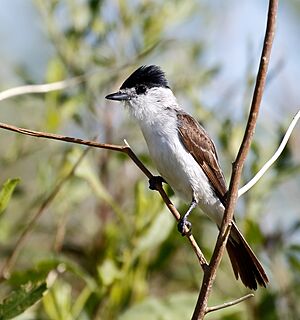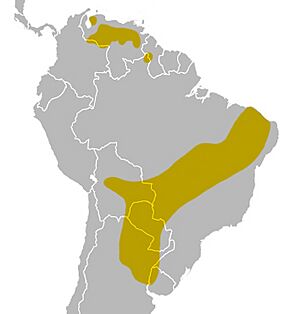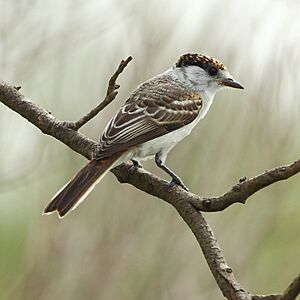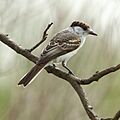Reed becard facts for kids
Quick facts for kids White-naped xenopsaris |
|
|---|---|
 |
|
| Adult, Santa Fe Province, Argentina | |
| Conservation status | |
| Scientific classification | |
| Genus: |
Xenopsaris
|
| Species: |
albinucha
|
 |
|
| Range in yellow | |
| Synonyms | |
|
Pachyrhamphus albinucha protonym |
|
The white-naped xenopsaris (Xenopsaris albinucha) is a small bird found in South America. It is also known as the reed becard or white-naped becard. This bird belongs to the Tityridae family and is the only member of its genus, Xenopsaris.
You can find these birds in warm, wet areas of South America. They live in countries like Venezuela, Brazil, Bolivia, Paraguay, Uruguay, and Argentina. They prefer open woodlands and other open forest areas. Most white-naped xenopsaris stay in one place, but some groups might migrate to different areas during certain seasons.
Scientists once thought this bird was a tyrant-flycatcher or a cotinga. However, it is now known to be closely related to becards and tityras. The white-naped xenopsaris is about 12.5 to 13 centimeters (5 inches) long. It has a white belly, a black head top (crown), and grey-brown upper parts. Males and females look similar, but females are a bit duller in color.
This bird mainly eats insects it finds on tree leaves and bushes. Sometimes, it also looks for insects on the ground. When it's time to nest, they build a simple cup-shaped nest in a tree fork. Both parents help incubate the eggs and feed their young. After the chicks learn to fly, the parents might split up to continue caring for them. The white-naped xenopsaris is not a very common bird, and scientists are still learning about it. However, it is not considered in danger of extinction.
Contents
About the White-naped Xenopsaris
How the White-naped Xenopsaris Got Its Name
The white-naped xenopsaris was first described in 1869 by a German-Argentine scientist named Hermann Burmeister. He found a bird near Buenos Aires and first placed it in the Pachyramphus genus, which includes becards. Later, in 1891, Robert Ridgway moved it to its own monotypic genus, Xenopsaris. Even though it was in its own genus, scientists knew it was still closely related to Pachyramphus.
A study in 1989 confirmed that Xenopsaris and Pachyramphus are like "sister" groups. However, the white-naped xenopsaris stayed in its own genus. This was because it is smaller, has different leg shapes, and its primary flight feathers are a different length. Also, male and female white-naped xenopsaris do not look very different (they lack strong sexual dimorphism). Their nests are also built differently.
For a long time, scientists were unsure which bird family this species belonged to. It was often moved between the cotinga family (Cotingidae) and the tyrant-flycatcher family (Tyrannidae). The 1989 study helped solve this mystery. It showed that Xenopsaris and six other genera formed a new family, which was later named Tityridae. This is the family where the white-naped xenopsaris is now placed.
Later, a 2007 study using mitochondrial DNA confirmed its place in the Tityridae family. It also showed its close relationship to the genera Pachyramphus and Tityra.
The name Xenopsaris comes from ancient Greek words. Xeno means "stranger," and Psaris is a name for a starling-like bird. The specific name albinucha comes from Latin. It means "white" (albus) and "nape" (nuchus), referring to the bird's white patch on the back of its neck.
There are two types, or subspecies, of white-naped xenopsaris. The most common one is called the nominate subspecies. The other is X. a. minor, which lives only in Venezuela. It was described by Carl Eduard Hellmayr in 1920.
What Does the White-naped Xenopsaris Look Like?
The white-naped xenopsaris is smaller than its relatives, the becards and tityras. It is about 12.5 to 13 centimeters (5 inches) long and weighs around 10 grams (0.35 ounces). The subspecies X. a. minor looks the same but is smaller overall. For example, its wing length is about 6.0 to 6.2 cm, while the common subspecies has wings about 6.4 to 6.6 cm long.
This bird has a white face, throat, chest, belly, and rump. Its belly might have a slight yellow tint. Males have a shiny black crown (the top of the head). The back of its neck (nape) is pale grey with a white band that separates the crown from the back. Its wings are dusky grey-brown with white edges on the inner flight feathers. The tail is dusky brown. Its strong bill, eyes, and legs are black.
Female white-naped xenopsaris look similar to males but are generally duller in color. Their crown might have a chestnut (reddish-brown) tint. Young birds look like adults but have greyish napes and more chestnut on their crowns. The feathers on their back, rump, and wings have ochre (yellowish-brown) scalloped edges.
The song of this bird is soft and does not travel far. You can hear it most often during the rainy season, but it can be heard at any time of day. Its call is a thin, high-pitched sound like "teep, tre'e'e'e'e'a eea wu'u'u'e'e'e-e-e-e-e-p" or "twip, tsiweeé, tseee, ti-ti-ti-ti". The first part of the song goes up and then down, and the last part is long. Sometimes, birds might only sing part of the song. They also make a squeaky, wavy screech. Males have been heard whistling while on the nest. When hunting for insects, males might make an "shreee" sound every few seconds.
The white-naped xenopsaris looks a bit like the cinereous becard, which lives in some of the same areas. However, the white-naped xenopsaris is smaller, has a longer tail, a thinner bill, whiter underparts, and browner upperparts.
Where the White-naped Xenopsaris Lives
The white-naped xenopsaris lives in different, separate areas. The main group of the common subspecies is found from northeastern Brazil, through Bolivia, Paraguay, and into northern Argentina and Uruguay. Another group of the same subspecies lives in Guyana. The subspecies X. a. minor is found in western and central Venezuela, and possibly in northeastern Colombia.
These birds usually stay in one place throughout the year. However, some observations suggest they might migrate in Bolivia and Brazil. A study in 2005 suggested they migrate in Santa Fe Province, Argentina, because they were not seen there during the southern winter (March to September). In 2006, the bird was seen for the first time in Peru. It was unclear if this was a bird that had wandered off course or a migrant.
They live in many different places, including Caatinga scrubland, forests near rivers, lightly wooded areas, and open areas with scattered trees. They usually live near water or damp places. They can be found from sea-level up to about 550 meters (1,800 feet) high.
Life and Behavior
Diet and Feeding Habits
The white-naped xenopsaris eats insects. Scientists have not yet studied what adult birds eat in detail. However, they know that chicks in the nest are fed grasshoppers, mantidflies, praying mantises, and mosquitoes.
Adult birds usually hunt alone or sometimes in pairs. Breeding pairs might hunt far apart from each other. They are shy, quiet, and hard to spot. They typically hunt from a perch on the outer edge of tree leaves. They watch for prey, then fly about 0.5 to 1.5 meters (1.6 to 5 feet) to snatch insects off leaves. They also hover above leaves to catch prey. Sometimes, they chase insects in the air. They often feed near the ground and can catch prey from the ground as well as from plants.
Reproduction and Life Cycle
White-naped xenopsaris are territorial, meaning the males defend their living area. The time they nest depends on where they live. In Venezuela, nesting happens during the rainy season (June to September). In Argentina, it happens during the southern summer (October to January).
Their nests are shaped like a cup, about 4.5 cm (1.8 inches) across, 4 cm (1.6 inches) high, and 1.8 cm (0.7 inches) deep. Nests are built from fine dry grass or woven plant fibers and small roots. They place their nests in the forks of tree branches, about 4 to 15 meters (13 to 49 feet) high in trees that are 15 to 20 meters (49 to 66 feet) tall.
A female usually lays three eggs, which are greenish with brown spots. Both parents take turns sitting on the eggs during the 14–15 day incubation period. These birds can be very calm during this time, staying on the nest even when people get very close. However, they are very aggressive towards other birds, like guira cuckoos, or animals that come near their nest. When the chicks hatch, they have dark skin, grey fuzz (down), and pink mouths. Pink mouths in baby birds like these are quite unusual.
All the chicks usually hatch within 24 hours of each other. After six days, their eyes open. After eight days, they are covered in whitish down. Chicks poop outside the nest by lifting their tail to the side. This means older chicks' nests are often surrounded by poop. Both parents feed and care for the chicks, taking turns. When one parent returns with food, it takes over caring for the chicks while the other goes to hunt.
The parents continue to feed the chicks for several days after they learn to fly (fledge). The family might travel together, or the parents might split up, each taking one or two chicks to care for.
Conservation Status
The white-naped xenopsaris is not common and is found in scattered locations across its range. However, it is not considered threatened by the IUCN Red List. This is because its population seems stable, with no signs of decline or big changes. It also lives in a very large area, estimated to be about 11 million square kilometers (4.2 million square miles). For these reasons, it is listed as a species of least concern.
Images for kids
-
Adult, Santa Fe Province, Argentina








